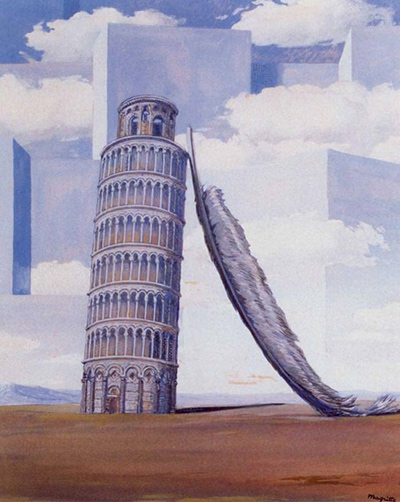Throughout his career, Rene Magritte was well-known for taking images and symbols from popular culture and recreating them in new, surreal ways.
He frequently borrowed imagery from postcards, brochures and similar souvenirs to create his strange art. ‘Memory of a Journey’ (painted in 1955) is an excellent example of this tendency. At first glance, it recreates a classic view of the distinctive and captivating Leaning Tower of Pisa.
However, Magritte elected to support his version of the famous tower with a giant (yet delicate) feather. In many respects, the painting is fundamentally playfully. It’s a visual jest that highlights the innate strangeness of the tower itself by pairing it with an explicitly surreal element.
Despite the dreamlike quality of ‘Memory of a Journey’, the tower itself is depicted with a high degree of verisimilitude. It is highly detailed and its general shape has not been noticeably distorted in any way. The artistic style employed in this painting is reminiscent of the semi-realistic postcards that Magritte undoubtedly viewed for inspiration.
‘Memory of a Journey’ was created in 1955 using oil paints. It was commissioned by a lawyer named Torczyner, who was a friend of Magritte. However, this was not the first time that the artist had depicted the Leaning Tower of Pisa. In 1949 and 1952, he had created images of the tower leaning against a spoon. In 1953, he painted it being supported by a feather for the first time. It is clear that the image of the tower exerted a strange attraction for the artist.
In Magritte’s native language, ‘Memory of a Journey’ is known as ‘Souvenir de Voyage’. It was almost certainly named after the book ‘Souvenirs de Voyage’ by J.A. Gobineau, as Magritte had this book in his library at the time he created the oil painting. It is possible that the book’s poetic language appealed to Magritte and that the playfullness of ‘Memory of a Journey’ reflects this language. ‘Memory of a Journey’ may not be one of Magritte’s most famous works, but it undoubtedly represents a subtle understanding of surrealism as an artistic ideal.




